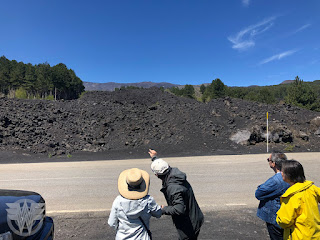It was a particularly welcome sight for wonder | wander | women who also grew up on a beautiful, fertile island nourished by an active volcano.
 |
| Mount Kanlaon, Negros Island, Philippines |
Etna's distinctive cone can be seen almost anywhere on the west side of Sicily, a perfect backdrop to tourist photos.
Volcanology professor Carmelo Ferlito from the University of Catania took us on an enlightening tour of the famous peak.
We were treated to a crash course on Etna's geological history - we followed lava flows from Roman and prewar times, to 1962 and more recent years.
Apparently Etna's constant smoking is actually a good sign, releasing gases frequently so larger explosions don't occur. White plumes are steam, meaning safe and normal activity. Black smoke signals an explosion of ash and gases, meaning an eruption.
Closer to the peaks we saw more signs of volcanic activity: lava flows cut like black rivers through the fields, and small cones pop up where the magma broke through.
The lava causes devastation but also nourishes the land: first lichen covers the black rock, then moss takes a foothold, then other plants break down the rock and ash into the rich soil famous for growing any crop imaginable.
A huge variation of plants grow on these slopes: silver birches and the Etna broom, which grows on lava and breaks it apart for other plants to take root; grape vines and fruit trees, even foreign plants like the American prickly pear.
We were delighted to reap the fruits of the volcano's labour at a local winery, after touring the beautiful vineyards.
Eating bruschetta and drinking wine, we admired this unique Sicilian landscape that nevertheless reminded us of the bounty of home.
 |
| Mount Kanlaon closer up |











No comments:
Post a Comment
Note: Only a member of this blog may post a comment.